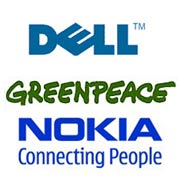
|
contents | business | |||||||
| Nokia and Dell Are the Most 'Greenpeaceful', the Research Says  Greenpeace says they have launched the 'Guide to Greener Electronics', which ranks companies on their use of harmful chemicals and electronic waste recycling. The guide will be used to create demand for toxic-free electronics which can be safely recycled, by informing consumers about company performance on these two issues. The scorecard ranks the 14 top mobile and PC producers and currently all fail to get a green ranking. Nokia and Dell share the top spot in the ranking. They believe that as producers they should bear individual responsibility for taking back and reusing or recycling their own-brand discarded products. Nokia leads the way on eliminating toxic chemicals, since the end of 2005 all new models of mobiles are free of polyvinyl chloride (PVC) and all new components to be free of brominated flame retardants (BFRs) from the start of 2007. Dell has also set ambitious targets for eliminating these harmful substances from their products. Greenpeace says they have launched the 'Guide to Greener Electronics', which ranks companies on their use of harmful chemicals and electronic waste recycling. The guide will be used to create demand for toxic-free electronics which can be safely recycled, by informing consumers about company performance on these two issues. The scorecard ranks the 14 top mobile and PC producers and currently all fail to get a green ranking. Nokia and Dell share the top spot in the ranking. They believe that as producers they should bear individual responsibility for taking back and reusing or recycling their own-brand discarded products. Nokia leads the way on eliminating toxic chemicals, since the end of 2005 all new models of mobiles are free of polyvinyl chloride (PVC) and all new components to be free of brominated flame retardants (BFRs) from the start of 2007. Dell has also set ambitious targets for eliminating these harmful substances from their products.Third place goes to HP, followed by Sony Ericsson (4th), Samsung (5th), Sony (6th), LG Electronics (7th), Panasonic (8th), Toshiba (9th), Fujitsu Siemens Computers (10th), Apple (11th), Acer (12th) and Motorola (13th). Lenovo is in bottom position. It earns points for chemicals management and providing some voluntary product take back programmes, but it needs to do better on all criteria. Companies have the opportunity to move towards a greener ranking as the guide will be updated every quarter. However penalty points will be deducted from overall scores if Greenpeace finds a company lying, practising double standards or other corporate misconduct. For now, companies are scored solely on information publicly available on their global websites. The scoring is weighted more heavily on the use of toxic substances in production rather than criteria on recycling, because until the use of harmful substances is eliminated in products, it is impossible to secure 'safe', toxic-free recycling. write your comments about the article :: © 2006 Computing News :: home page |